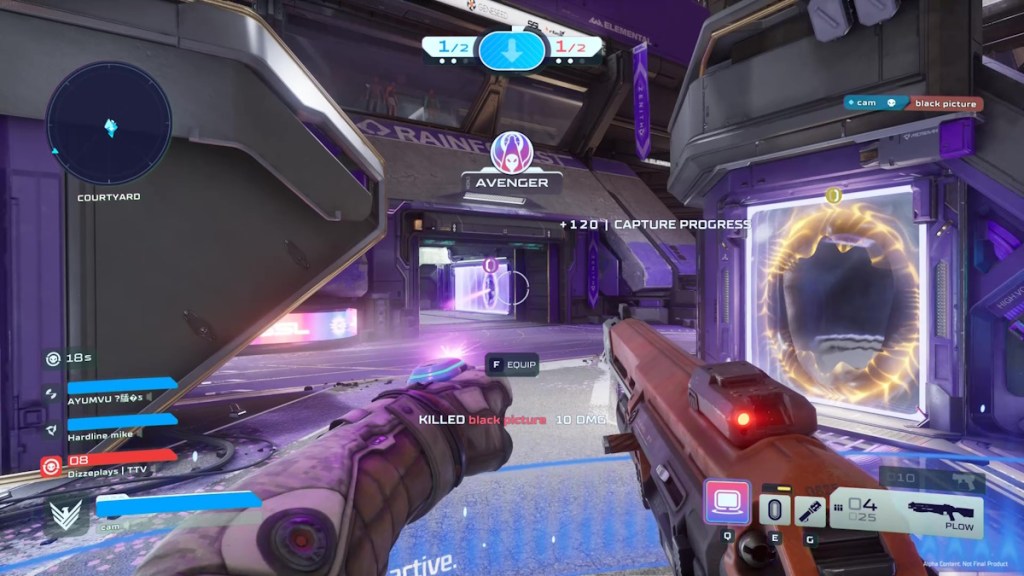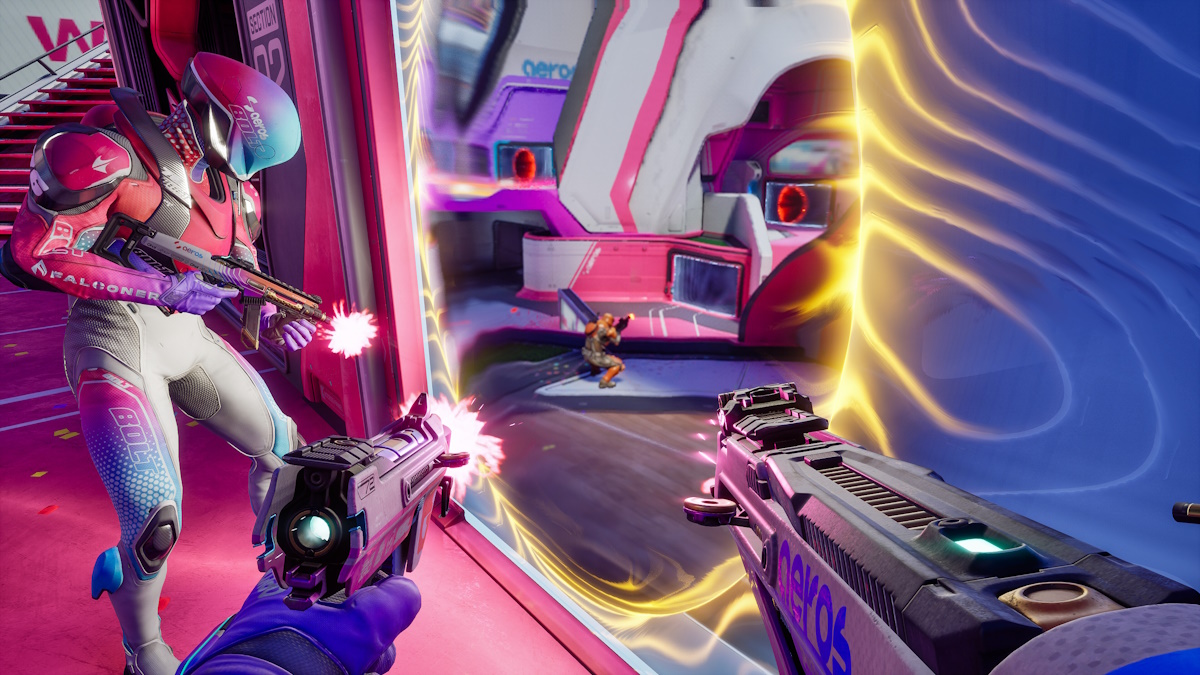I recently got to play a preview of the free-to-play PvP shooter Splitgate 2. After six hours, it’s clear to me that developer 1047 Games is trying things a bit differently than expected. The original shooter was celebrated as “Halo meets Portal,” introducing portal gameplay to arena-style shooting. It worked, and Splitgate exploded in popularity.
Those eager to jump into its sequel for more of the same may be alarmed to learn that Splitgate 2 won’t just be more of the same. Sure, there’s still Halo-style shooting and Portal-esque, erm, portaling. But its gameplay feels supercharged, focusing on character abilities and high-octane combat in smaller arenas where unseen crowds cheer for their favorite bloodsport.

Team player
Splitgate 2 lets you represent factions and perform stunts for the folks at home. Earning points and completing feats causes invisible fans to cheer as a “coach” feeds you match info in a sprightly British accent.
There are three factions you can pick and customize in Splitgate 2. First, you have Aeros, which favors speed and agility. Meridian members dress up in sleek purple and black, looking more like the secret soldiers of a cyberpunk megacorp. Finally, you have Sabrask, a militaristic group that sports heavy orange armor.
You can customize each faction’s loadout, all of which offer you the choice of three gun types that fall under long-range rifles, machine guns, and a shotgun. Aeros does swap out a shotgun for a bullet-spitting SMG, however. You also get one of two equipment options and a Team Trait that offers everyone on your team a small buff.

There’s also a smattering of equipment and special abilities unique to every faction. Meridian lets you heal allies with a health grenade or to temporarily see through walls, for example. Sabrask gives you a shield you can place on the ground, allowing you to shoot through it while it blocks enemy bullets.
Swap meet
You can swap between and customize factions and weapon attachments between missions, giving you the option to change things to better suit your team composition. Often, during a losing match, I would quickly return as a Sabrask bruiser.
The Sabrask shotgun is ridiculous, capable of delivering a thunderous buckshot slap to the face that can bring someone down in one or two shots. Add an attachment to increase its range, and you will end up with something that should be illegal. But the gun’s reload speed is so painfully slow that I often found it better to grab a discarded gun off the ground and jump back into the fight.
Meridian was my other favorite faction. I naturally gravitated to its three-shot burst rifle. It wasn’t exactly like my beloved Battle Rifle from Halo, but picking off enemies at a distance with it still left me with the same self-satisfied smirk on my face.

Back to the arena
There were two modes to try in the preview. Team Deathmatch is, naturally, a fairly well-trodden mode for shooters, where two teams duke it out for the most kills. There is a small twist, however.
Team Deathmatch is round-based in Splitgate 2. Every 15 kills, the game would pause so you could take a breath, tinker with your build, or chat strats with your team. After eight seconds or so, you’re sent back out to try and earn another 15 kills. The first team to win three rounds takes home the gold.
The other mode was Hotzone, Splitgate 2‘s take on King of the Hill. But, like with Team Deathmatch, it comes with an unexpected wrinkle. Zone control is shared between the two teams, and the last team member on the point when it reaches 100% claims the score. Naturally, this means that a team can claim a control point for the majority of the time, only to get wiped and lose the point within seconds. The team with two control captures wins the match.
Controlling chaos
There were two power weapons in the preview. The Fubar rocket launcher could shoot one rocket at a time or everything it has loaded by zooming in first. The other is the Splitstream rifle, which you can split into two weapons for dual-wielding action. Before the preview, we were in a brief meeting with Ian Proulx, the creative director of Splitgate. During the chat, Proulx compared the gun to Halo 2-style dual-wielding. And he’s not mistaken. Nothing else I’ve used comes so close to the golden days of that pre-patch SMG/Pistol combo like the Splitstream.

The preview included a handful of maps to try. Maps in the Splitgate 2 preview felt tightly designed, made to funnel two teams of four toward the center where a lot of the action took place. Teams fought to hold sections that offered map control while smaller skirmishes lit up hallways and various rooms. Power weapons that spawned into the map could change the tides in moments.
Those familiar with classic Halo multiplayer may have felt their eyebrow rise a bit. As someone who played way too much Halo 3 in college, the Splitgate sequel still gladly evokes its spirit. Gunning for map control while watching for power weapon spawns is peak Halo, with the portal gun again presenting more tactical options. You can sprint, slide, and hover in the air. The pacing, along with the default abilities, means Splitgate 2 is less Halo 3 and more Halo 5 played fast-forward.
Picking up the pace
Knowing you can break a team’s control with smart portal placement means Splitgate 2 moves fast as hell. Getting past a choke point is easier when you can just bust through a science fiction-hole in the wall. I was often surprised by how quickly a 15-kill round in Team Deathmatch would go.
This is the start of where I feel Splitgate 2 falters a bit. The game moves so fast that the sudden stops are jarring. I wonder if upping the kill score to 20 would make things feel a bit less bumpy, but the speed feels baked in. Team Deathmatch games can wrap up in less than ten minutes, and I felt burnt out by the time I played for about an hour.
Hold that thought
Hotzone was often just as swift but had its own issues. Respawns in Hotzone are not rigid and will increase by small amounts the longer the match lasts. Dying early in Hotzone means you get to respawn quickly; by default, you return to the fray after five seconds. Every eight seconds, the respawn time increases by one second until capping at 20.

Getting kills against enemy players knocks three seconds off your teammate’s respawn timer. Smart or aggressive plays are incentivized, as playing it safe can mean allowing the opposing team to score nearly unopposed. Everyone who has played multiplayer team-based shooters knows the pressure of being the last alive on your team, eyeballs burning holes into the back of your head. That intensity is so much higher in Hotzone.
But it can be a bit aggravating for those stuck in respawn hell. Having to watch the control point tick along for nearly 20 seconds while the opposing team enjoys a picnic in the point is damn near unbearable. The high-risk, high-reward nature of the respawn timer may make for some exciting moments, but it’s just as true that it can lead to waiting in frustration. Considering how expedient the gameplay is, the sudden stop and long pause between the blistering action feels off.
I can split these gates
I have learned that I am laughably shit at using portals in Splitgate 2. There were no large, vertical maps in the preview, meaning most portal options existed to get a drop on enemies or move to a point on the map a bit faster. Early on, enemy players often got the better of me. I was chasing one player down when they dropped a portal to their right and left. They entered the latter and suddenly were across the room.
I died like the idiot I was, but I started to learn. Before the end of my time with the game, I was able to move around the map for positioning. If an enemy player was dug in, I created a portal behind them and blasted through it from safety.

Thrills and spills
Despite the concerns, the Splitgate 2 preview still offered more than a fair share of excitement. Both the movement and shooting felt meticulously fine-tuned.
If you told me the game was ready to fully launch tomorrow, I’d believe you. The maps are fantastic and varied, with plenty of ramps and angles to use to your advantage. It can be thrilling to charge into a fight with an ally and use a portal to sandwich enemy members. Personally, I had a lot of fun with the game despite my limited time with it and the misgivings the changes brought.
Splitgate 2‘s blistering pace will be something to get used to, but the gunplay still feels damn good in the preview. It’s too early to say if Splitgate 2 will reach the dizzying but temporary heights of its predecessor. But the game will be available to play in Alpha form on August 21, 2024, giving everyone a chance to try it out.










